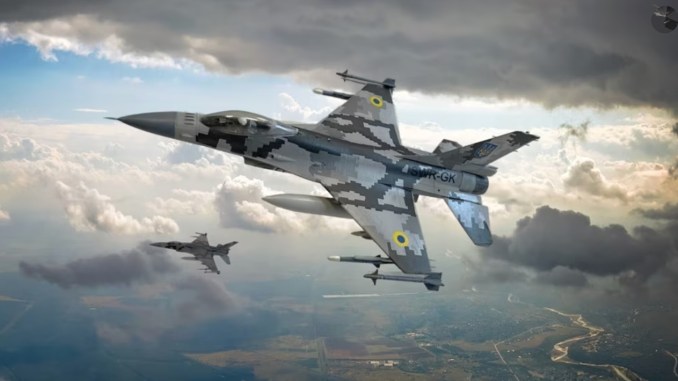
The F-16s will allow a more efficient use of Western weapons and, alongside Western air defense systems and AEW assets, would help to push back Russian planes from the frontlines.
Ukrainian Air Force Command’s chief of aviation, Brigadier General Serhiy Golubtsov, has shed new light on the larger tactical and strategic implications centered around the Western F-16s about to reach Ukraine.
The rare, wide-ranging interview with Donbas Realiy reveals how the jet is intricately linked to the optimum performance of the Western weapons in its arsenal. The F-16s themselves are not a “panacea” for air superiority, Golubtsov warned, echoing earlier predictions by many Western experts.
The versatile, multirole jet will augment and replace the Soviet-era fighters tweaked to fire the weapons donated by the West, which however encountered some difficulties. These include the JDAM (Joint Direct Attack Munition), AGM-88 HARM (High-Speed Anti-Radiation Missile), ADM-180 MALD (Miniature Air-Launched Decoy) and the Storm Shadow/SCALP-EG ALCM (Air-Launched Cruise Missile).
The interview also fascinatingly bares how tactics and strategy around a single weapon change when it is either available in mass or there are variations in the number of assets that can employ them, or both. The following is a paraphrasing of Golubtsov’s responses to a series of exhausting and detailed questions found in the original interview.
Two F-16 Fighting Falcons from the 148th Fighter Wing fly in formation on Oct. 30, 2019. (Image credit: U.S. Air Force).
” data-medium-file=”https://i0.wp.com/theaviationist.com/wp-content/uploads/2024/06/F16-1.jpg?fit=460%2C259&ssl=1″ data-large-file=”https://i0.wp.com/theaviationist.com/wp-content/uploads/2024/06/F16-1.jpg?fit=706%2C397&ssl=1″ class=”size-large wp-image-86841″ src=”https://zephyrnet.com/wp-content/uploads/2024/06/the-f-16-is-not-a-panacea-for-air-superiority-says-ukrainian-aviation-chief-1.jpg” alt width=”706″ height=”397″ srcset=”https://zephyrnet.com/wp-content/uploads/2024/06/the-f-16-is-not-a-panacea-for-air-superiority-says-ukrainian-aviation-chief-1.jpg 706w, https://zephyrnet.com/wp-content/uploads/2024/06/the-f-16-is-not-a-panacea-for-air-superiority-says-ukrainian-aviation-chief-4.jpg 460w, https://zephyrnet.com/wp-content/uploads/2024/06/the-f-16-is-not-a-panacea-for-air-superiority-says-ukrainian-aviation-chief-5.jpg 128w, https://zephyrnet.com/wp-content/uploads/2024/06/the-f-16-is-not-a-panacea-for-air-superiority-says-ukrainian-aviation-chief-6.jpg 768w, https://zephyrnet.com/wp-content/uploads/2024/06/the-f-16-is-not-a-panacea-for-air-superiority-says-ukrainian-aviation-chief-7.jpg 678w, https://i0.wp.com/theaviationist.com/wp-content/uploads/2024/06/F16-1.jpg?w=1024&ssl=1 1024w” sizes=”(max-width: 706px) 100vw, 706px” data-recalc-dims=”1″>
Ukraine’s new glide bomb
Answering why the JDAM bombs did not have a “massive effect” on the battlefield, despite being used from early on, Golubtsov cited “limited” quantities. Initially there also was a lack of aircraft, as converting them to use the new weapons was a slow process, but now enough aircraft have been converted. The new weapons were first tested to “understand their effectiveness” on the battlefield and were thus provided in “trial batches,” with “many more orders” subsequently.
But the Russians “simply went through this process earlier,” said the officer. It’s in this context that Golubtsov mentioned Ukraine is “working on the conversion and creation of [their] own modified aerial bombs, based on ordinary falling ones.” Ukraine will begin the first tests of Ukrainian-made guided glide bombs, but for now is relying on Western GBU-39s and GBU-62s. The Aviationist had previously reported about the effectiveness of GBU-39s in Ukraine.
However, these bombs cannot be used on Russian targets located “in depth” since it would mean entering the coverage zone of Moscow’s long-range surveillance radars located in its sovereign territory. Discussions are currently ongoing with partner countries to obtain the “permission to work on the territory of the Russian Federation.”
Golubtsov also shed light on the redesigning of the wirings of its Soviet-origin aircraft to make the electronic and electrical weapons control mechanisms compatible with the Western-origin GBUs. The small-diameter bomb” are “almost impossible to shoot down with anti-aircraft weapons,” said the officer.
A single aircraft can carry many of such bombs, where each bomb has its own “programmed target.” A US Air Force photo from Apr. 20, 2023, showed an A-10 Thunderbolt II carrying 16 GBU-39s, with four each on four hardpoints. This allows one plane to “hit several targets at once,” and the bombs’ “small effective surface” (or small radar cross section) for Russian air defense allows “almost 100%” strike rate.
Sixteen GBU-39s under an A-10 Thunderbolt II, assigned to the 422nd Test and Evaluation Squadron (TES) at Nellis Air Force Base, Nevada, Apr. 19, 2023. (Image credit: US Air Force).
” data-medium-file=”https://i0.wp.com/theaviationist.com/wp-content/uploads/2024/06/F16-2.jpg?fit=460%2C259&ssl=1″ data-large-file=”https://i0.wp.com/theaviationist.com/wp-content/uploads/2024/06/F16-2.jpg?fit=706%2C397&ssl=1″ class=”size-large wp-image-86842″ src=”https://zephyrnet.com/wp-content/uploads/2024/06/the-f-16-is-not-a-panacea-for-air-superiority-says-ukrainian-aviation-chief-2.jpg” alt width=”706″ height=”397″ srcset=”https://zephyrnet.com/wp-content/uploads/2024/06/the-f-16-is-not-a-panacea-for-air-superiority-says-ukrainian-aviation-chief-2.jpg 706w, https://zephyrnet.com/wp-content/uploads/2024/06/the-f-16-is-not-a-panacea-for-air-superiority-says-ukrainian-aviation-chief-8.jpg 460w, https://zephyrnet.com/wp-content/uploads/2024/06/the-f-16-is-not-a-panacea-for-air-superiority-says-ukrainian-aviation-chief-9.jpg 128w, https://zephyrnet.com/wp-content/uploads/2024/06/the-f-16-is-not-a-panacea-for-air-superiority-says-ukrainian-aviation-chief-10.jpg 768w, https://zephyrnet.com/wp-content/uploads/2024/06/the-f-16-is-not-a-panacea-for-air-superiority-says-ukrainian-aviation-chief-11.jpg 678w, https://i0.wp.com/theaviationist.com/wp-content/uploads/2024/06/F16-2.jpg?w=1024&ssl=1 1024w” sizes=”(max-width: 706px) 100vw, 706px” data-recalc-dims=”1″>
‘Russia has mass and numbers’
Golubtsov also placed Russian industrial output’s superiority over the West’s technologically advanced weapons, where the latter’s “modern and accurate” ammunition is offset by Moscow’s mass manufacturing lead. This was in response to the interviewer pointing to Ukrainian President Volodymyr Zelenskyi’s comment about Russia releasing “more than 3,000 aerial bombs every month.”
“The Russians have much more of them [and] have been preparing for this war for probably more than a dozen years,” said Golubtsov. “[The Russian] Su-35 or MiG-31 aircraft have much greater potential than the aircraft we currently have in service. Therefore, we have hope for the modernization of our planes, as well as for Western-made planes.”
F-16s are not an answer, but integrate disparate weapons
Golubtsov said that the F-16 is “not a panacea” and they are not expecting anything unrealistic: “It will be difficult to gain air superiority with one aircraft.” The effort would be a much larger, complex undertaking with E.W. (Electronic Warfare) platforms and “long-range radar detection aircraft.” On May 29, in fact, Sweden officially confirmed the transfer of ASC 890 Airborne Early Warning aircraft to Ukraine.
But the F-16s, along with the Patriot Air Defense system and Link 16 datalink, can be used in an integrated network which will help “drive away from the line of combat those [Russian] planes that [fire] anti-aircraft missiles”. These include Su-35 or the Su-30SMs, which if “[they] get too close, [they] will be in the hit zone.”
Golubtsov presented a very pragmatic picture of altering the balance of airpower. “If not air superiority”, the Saab ASC 890, F-16s and the Western ADs allow “parity” in the air where, even if Russian jets are pushed back “at least 30-50 kilometers,” it can be considered “a turning point.” Golubtsov did not mention these platforms specifically in this particular comment, but his reference to them throughout the interview and the implication of using them in a “complex” implies this techno-tactical thinking.
Reducing the airspace for Russian fighters will allow more freedom for ground operations, where Ukraine’s Su-25 ground-attack jets, possibly armed with the new domestically developed glide bomb, HIMARS (High-Mobility Artillery Rocket Systems) and other artillery systems can undertake more sector-wide coordinated attacks. Currently, the Ukrainian Army’s major tactical land positions constantly come under attack from UMPC-FAB bombs dropped from Russian Su-34 Fullback fighter-bombers.
So far, Su-25s are only being used as low level ground attack platforms in CAS (Close Air-Support)-type roles. Ukraine, however, used its unguided rockets “in the first year,” following which they received Western alternatives such as Zuni rockets. The standard pop-up flight profile sees the Frogfoot flying at tree-top altitude, climbing to fire the rockets from the pods, releasing flares and turning away to return back to low altitude.
Enhancing Storm Shadow and HARM missiles’ effectiveness
The F-16s arrival will streamline the use of existing Western weapons like Storm Shadows/SCALP-EG, AGM-88 HARM, AASM-Hammer glide bombs or the ADM-160 MALD. Their reduced effectiveness was primarily owing to the limits of the launcher aircraft, like the Su-24 Fencer, Su-27 Flanker and the MiG-29. While the weapons themselves still demonstrated a good effectiveness, the flexibility of their employment was limited by the extent of their integration on the Soviet-made fighters.
For an instance, Golubtsov mentioned how target coordinates for Storm Shadow are currently pre-loaded on the ground to reduce the tedious mid-air acquisition and launch sequences, allowing to minimally expose the Su-24s to Russian SAMs (Surface-to-Air Missiles). Indeed, Russian “air defense has also shot down” a number of Storm Shadows, beside capturing near intact ones on at least two instances. Their repeated success is due to “unexpected” flight routes and the employment of MALDs, unmanned aircraft and HARMs to act as “distracting targets” that force Russian AD crews to give up their positions.
“Two-day operation to evacuate captured Storm Shadow successfully completed” — Rogozin
The missile has just been handed over to one of Russia’s defense enterprises, whose specialists will “decipher” the control system algorithms of this missile and share it with air defense… pic.twitter.com/RyobaRSmHF
— Lord Bebo (@MyLordBebo) July 6, 2023
The Lugansk, Donetsk and Crimean sectors are instances of Storm Shadow successful hits. For an instance, the destruction of the BSF (Black Sea Fleet) headquarters in Sevastopol on Sep. 13, 2023, was an example of a highly coordinated and sophisticated tactics using Storm Shadow ALCMs (Air-Launched Cruise Missiles), three of which slipped through Russian air defenses and struck their targets. Golubtsov mentioned how using “distracting targets” like UAVs, HARM and MALDs increased the chances of Storm Shadow missiles to reach the target.
Ukraine’s Black Sea also consumes a lot of planning and reconnaissance resources. They are preceded by extensive airborne radar, ELINT/EW (Electronic Intelligence/Warfare) and optical reconnaissance using NATO aircraft like the E-3 Sentry AWACS, RC-135 Rivet Joint, MQ-9 Reaper and MQ-4 Global Hawk drones.
But Western aircraft like the F-16 (or the French Mirage 2000-5s announced by Paris) that can operate Storm Shadows/SCALP-EGs easily, without the tricky modifications required by the Su-24, will allow releasing them mid-flight, while receiving real-time data from the aerial surveillance assets, shortening the targeting cycle.
Russia’s Tor air defense system (Image credit: Russian Ministry of Defense).
” data-medium-file=”https://i0.wp.com/theaviationist.com/wp-content/uploads/2024/06/F16-3.jpg?fit=460%2C279&ssl=1″ data-large-file=”https://i0.wp.com/theaviationist.com/wp-content/uploads/2024/06/F16-3.jpg?fit=706%2C429&ssl=1″ class=”size-large wp-image-86843″ src=”https://zephyrnet.com/wp-content/uploads/2024/06/the-f-16-is-not-a-panacea-for-air-superiority-says-ukrainian-aviation-chief-3.jpg” alt width=”706″ height=”429″ srcset=”https://zephyrnet.com/wp-content/uploads/2024/06/the-f-16-is-not-a-panacea-for-air-superiority-says-ukrainian-aviation-chief-3.jpg 706w, https://zephyrnet.com/wp-content/uploads/2024/06/the-f-16-is-not-a-panacea-for-air-superiority-says-ukrainian-aviation-chief-12.jpg 460w, https://zephyrnet.com/wp-content/uploads/2024/06/the-f-16-is-not-a-panacea-for-air-superiority-says-ukrainian-aviation-chief-13.jpg 128w, https://zephyrnet.com/wp-content/uploads/2024/06/the-f-16-is-not-a-panacea-for-air-superiority-says-ukrainian-aviation-chief-14.jpg 768w, https://i0.wp.com/theaviationist.com/wp-content/uploads/2024/06/F16-3.jpg?w=1024&ssl=1 1024w” sizes=”(max-width: 706px) 100vw, 706px” data-recalc-dims=”1″>
Russian Tor-M2 short-range AD system has also identified the Storm Shadow as a “very difficult” target to intercept. One phase where the ALCM is more vulnerable to being shot down is during its terminal stage. The missile, in fact, discards its nose cap to reveal the optical DSMAC seeker, makes a climb and dives down on the target.
Also, the HARM can be used thanks to the data received by sensors present on some of the F-16s, instead of being fired in the lock-on after launch mode, as done right now. In this mode, the weapon is launched in the expected direction of the threat radar and, if the radar is activated, the HARM detects the emission and pursues it.
Russian AD crews, after losing a lot of systems, later learnt to identify the HARMs, turning off their radars and letting the missiles pass, before turning on again to attempt shooting down the weapons which the HARMs were covering. Golubtsov says the anti-radiation missile is used every day, showing their effectiveness, and will be even more effective when used by the F-16.
Force Multiplier
Needless to say, with the F-16s, the remaining Ukrainian MiG-29s, Su-27s and Su-24s can be freed up for other missions or the same missions, carrying even more payload. Maximizing the strike assets ensures redundancy. Since the war is expected to last longer, it also gives the Ukrainians the leisure to “try” and refine tactics.
More importantly, Ukraine’s Su-25s are also being “modified” to carry the French AASM Hammer guided bomb. The weapon features a rocket motor to increase its range. In mid-April a video emerged, showing a Ukrainian Su-27 dropping the AASM Hammer, which subsequent analysis showed could be a SEAD/DEAD (Suppression/Destruction of Enemy Air Defense) tactic.
- SEO Powered Content & PR Distribution. Get Amplified Today.
- PlatoData.Network Vertical Generative Ai. Empower Yourself. Access Here.
- PlatoAiStream. Web3 Intelligence. Knowledge Amplified. Access Here.
- PlatoESG. Carbon, CleanTech, Energy, Environment, Solar, Waste Management. Access Here.
- PlatoHealth. Biotech and Clinical Trials Intelligence. Access Here.
- Source: https://theaviationist.com/2024/06/11/ukrainian-aviation-chief-interview/




